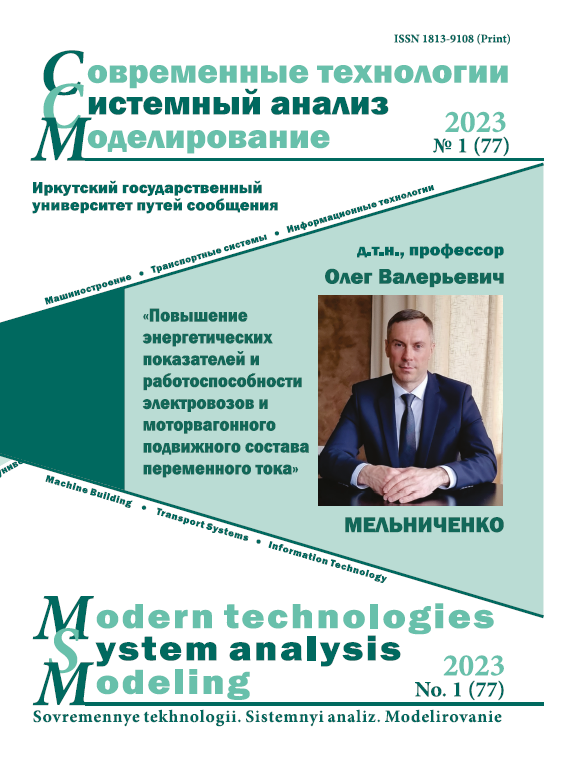Simulation of optimum control of asynchronous drive
Keywords:
asynchronous motor, SimInTech, simulation modeling, vector control, optimal controlAbstract
Currently, asynchronous motors form the basis of an automated electric drive, which accounts for the bulk of the electricity consumed. In this regard, the issues of rational consumption of energy resources are of paramount importance. In the paper under consideration, a method for optimal control of an asynchronous motor according to the criterion of minimizing the consumed current is proposed. The mathematical model of the engine and its control systems are made by the method of vector control in a rotating coordinate system dq. The study of the proposed control method was carried out on the basis of the domestic software product SimInTech of the «3V Service» LLC company. As a result of the simulation modeling, the dependence of the motor stator current on the rotor flux linkage has been established, which has a parabolic shape at fixed values of the electromagnetic torque. The minimum value of the current corresponds to the optimal values of the flux linkage. This nature of the dependences served as the basis for using the step search system algorithm in the developed optimal motor control system with a minimum value of current consumption. The developed mathematical model of an asynchronous motor is controlled by an optimal controller, which makes it possible to reduce the consumed current to optimally low values at different values of the electromagnetic torque. The research results presented in the paper indicate an increase in the energy efficiency of an asynchronous drive due to the optimally low consumption of the stator current by the motor, therefore, the materials of the article can serve as a theoretical basis for the development and implementation of energy-saving control systems for an asynchronous motor.
References
Костенко М.П. Электрические машины. Специальная часть. Л. : Госэнергоиздат, 1949. 708 с.
Blaschke F. Das Prinzip der Feldorientierung, die Grundlage für die Transvektor-Regelung von Drehfeldmaschinen // Siemens-Zeitschrift. 1971, Vol. 45, S. 757–760.
Vas P. Sensorless Vector and Direct Torque Control. Oxford : Oxford University Press, 1998. 729 p.
Bajenescu Titu-Marius. The Insulated-Gate Bipolar Transistors (IGBT) and their Reliability // Electrotehnica, Elec-tronica, Automatica. 2012. Vol. 60. № 2. URL : https://www.researchgate.net/publication/289745294_The_insulated-gate_bipolar_transistors_IGBT_and_their_reliability (Дата обращения 7.11.2022).
Кулинич Ю.М. Электронная преобразовательная техника. М. : УМЦ ЖДТ, 2015. 204 с.
Колпаков А. Перспективы развития электропривода // Силовая электроника. 2004. № 1. С. 46–48.
Branko Blanusa. New Trends in Efficiency Optimization of Induction Motor Drives // New Trends in Technologies : Devices, Computer, Communication and Industrial Systems. 2010. Р. 341–358.
Лазарев Г. Высоковольтные преобразователи для частотно-регулируемого электропривода. Построение различ-ных систем // Новости электротехники. 2005. № 2 (32). С. 15–20.
Вольдек А.И., Попов В.В. Электрические машины. Машины переменного тока. СПб. : Питер, 2010. 350 с.
Шрейнер Т.Р., Дмитренко Ю.А. Оптимальное частотное управление асинхронными электроприводами. Киши-нев : Штиинца, 1982. 224 с.
Виноградов А.Б., Изосимов Д.Б., Флоренцев С.Н. Оптимизация КПД системы векторного управления асин-хронным тяговым электроприводом с идентификатором параметров // Электротехника. 2010. № 12. С. 12–19.
Шонин О.Б., Пронько В.С. Энергосберегающие алгоритмы частотного управления асинхронным приводом с уточнением области минимума потерь на основе методов нечеткой логики // Записки Горного института. 2016. Т. 218. С. 270–280.
Герман-Галкин С.Г., Карташов Б.А., Литвинов С.Н. Модельное проектирование электромеханических ме-хатронных модулей движения в среде SimInTech. М. : ДМК Пресс, 2021. 494 с.
Калачёв Ю.Н. SimInTech: моделирование в электроприводе. М. : ДМК Пресс, 2019. 98 с.
Моделирование векторного управления асинхронным приводом вспомогательных машин электроподвижного состава / Ю.М. Кулинич, С.А. Шухарев, В.К. Духовников и др. // Вестн. науч.-исслед. ин-та ж.-д. трансп. 2022. Т. 81. № 1. С. 23–30.
Усольцев А.А. Частотное управление асинхронными двигателями. СПб. : СПбГУ ИТМО. 2006. 94 c.
Калачев Ю.Н. Векторное регулирование (заметки практика). М. : ЭФО, 2013. 66 с.
Pradeep J., Devanathan R. Adoption of Park’s Transformation for Inverter Fed Drive // International Journal of Pow-er Electronics and Drive System. 2015. Vol. 5. № 3. Р. 366–373.
Bellan D. Clarke Transformation Solution of Asymmetrical Transients in Three-Phase Circuits // Energies. 2020. 13. 5231. DOI 10.3390/en13195231.
Kulinich Yu.M., Shukharev S.A. Application of an Extreme Control System to Operate the Reactive Power Com-pensator of an Electric Locomotive // Russian Electrical Engineering. 2016. Vol. 87. № 2. 3 p.


